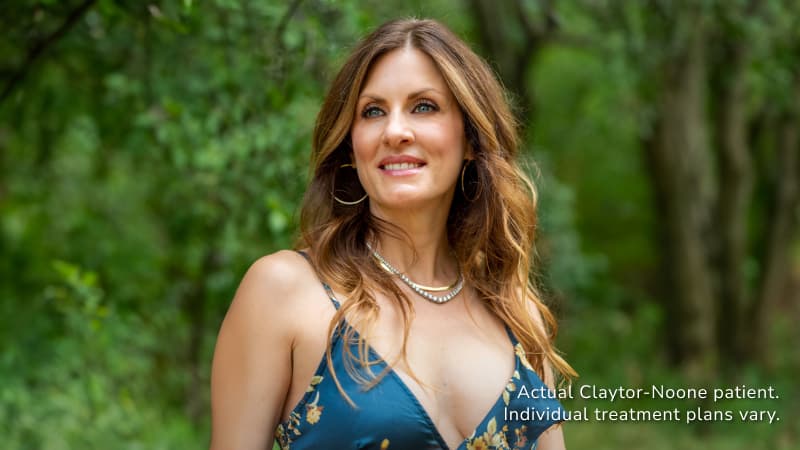MyEllevate Neck Lift
State-of-the-art, light-guided suture system for a minimally invasive neck liftR. Brannon Claytor, M.D. FACS is the premiere board-certified surgeon in the tri-state area to offer a new and exciting, minimally invasive lower face jawline and neck rejuvenation procedure using a light-guided surgical system. This revolutionary approach to address the underlying muscles and glands of the neck precedes all other treatments with advanced technology that sculpts the underlying neck structures percutaneously.
The other benefits of this state-of-the-art procedure include: no lengthy incisions; no scarring; local anesthesia; performed in about an hour; a two week recovery time; half the cost of a normal neck lift; and can be performed in Dr. Claytor’s private surgical suite where patients may recover and return home the same day.
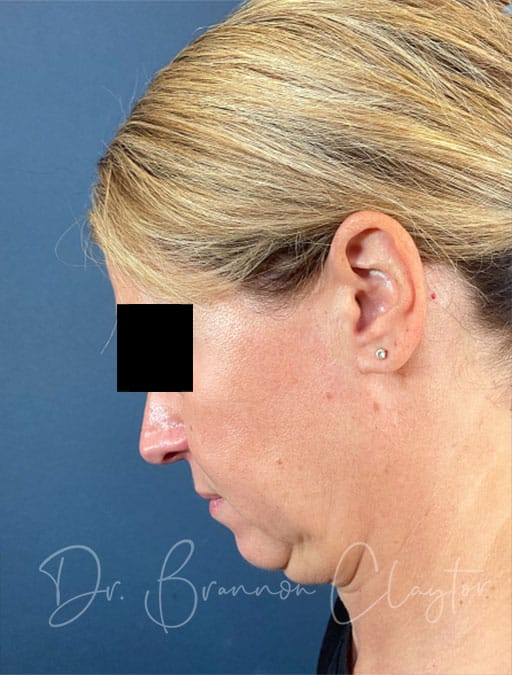
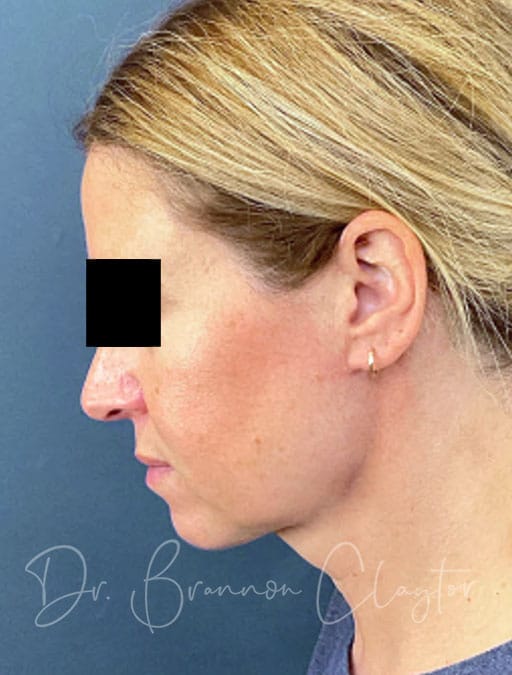
This 50-year-old patient wished to address skin laxity on her neck and jawline. After photos show results 6 weeks post-open posterior neck lift with MyEllevate suture.
*Individual results may vary.
Who is the ideal candidate for this procedure?
If you look at your profile and see that your neckline is looking like a ski slope, rather than a nice right angle underneath the chin, you are likely an ideal patient. The ideal candidate is a patient who:
- Has minimal skin laxity (i.e. without excessive sagging skin)
- Is just starting to show early signs of aging
- Is in their 30s to early 50s
Also, patients who have glands that are prominent underneath the neckline—which happens to a lot of people genetically and is not even age-related—may also experience a great result. The list goes on, as even a patient who is thinking about having a skin tightening procedure may require this to address the underlying muscles and glands, which are causing the neck to look aged. This is the only procedure that is percutaneous and addresses these problem areas.
Dr. Claytor’s minimally invasive neck lift, explainedVideo Transcript
Dr. Claytor here. Wanted to share with you the non-surgical neck lift. How does that work? First of all, we need to understand anatomy. So here we have the patient’s jawline. Here’s their jawbone. Here is the underlying bony structure and here is that contour on the neck with that hanging fat. And so it’s not just an excess amount of skin but it’s also extra fat. So how do we deal with that?
First thing we have to do is come in with liposuction, so that’s a liposuction cannula. Then we take and come in just behind the ear and go down here and suction out that fat. And so you can see these small holes at the end of the liposuction cannula suck out that fat. And that helps reduce the amount of fat volume that’s in the neck. That was really all we had years ago.
And then we moved on and we developed the precision TX SmartLipo laser. So this is a laser that we can put in also just behind the ear and reach down here, or you can also enter just underneath the chin here and come in. And the thing that’s unique about the Precision TX SmartLipo laser is that it’s bi-directional. It shoots out the end of the laser as well as out the side so it’s a side-firing laser as well. And what that allows me to do is turn, and so I can turn that laser and shoot out at the skin, or I can shoot down at the underlying muscle. When I shoot out at the skin I’m tightening the skin. When I shoot down at the muscle I’m removing the fat layer in addition to the liposuctioning.
Then, really, the exciting part about the non-surgical neck lift is the Ellevate suture. This is a absolutely transformative part of neck rejuvenation. And the reason for that is we can remove this fat, we can tighten the skin, but ultimately we’re left with the basic triangle that makes up the angle of the jaw. And we’ve got this extra skin here. If you want to take this distance which is longer than this distance and bring that tissue back up and recreate that beautiful neckline.
So how do we do that with the Ellevate suture? So this is the device here; it detaches so that I’m able to pass it through and then reattach it to the light source. And the reason the light source is important is it helps get it that exact level as you’re doing that tissue dissection. And so you start out right here in the middle: so we’ll bring down our magnets. which represent the pivot points. Again remember the first part is the liposuction where we go in with the cannula and we remove most of the fat cells. Now the problem with that, if you do that then you may have the hanging skin. So you come along with the precision TX SmartLipo laser and you go in and—remember it’s bi-directional so you can be firing the laser into the skin which helps with skin tightening and also removing more of the fat.
Now we need to work on taking that loose skin that’s had the fat removed with liposuction and the skin tightened with the Precision TX, and we need to tighten it using the Ellevate suture. So the way we do that is this enters into the tissue and then I slide it along here and then pull through the suture. So effectively what this looks like is, I put this stitch here and then I reattached this, and now I’m able to tunnel over to my next point. And so I go over to here and then when I pop out of the skin I’m able to pull this through. And this sits like such. So you can start to see how this suture underneath the skin is going to allow for the redraping and pulling.
The real key is that we need to anchor it up here. That is the anchor. Now we’re going to come up to here—the suture is going to go along to here. And then we’re going to go up tunnel again further and come out right behind the ear. The ear has a dense amount of connective tissue attached to the mastoid bone and will allow us to anchor the suture as we’re pivoting and coming back down here where we want to have the pull, and pull this tissue back but it needs to be anchored off of here. So now we come along here, bring it through here, pop it out, draw it through the tissue, and the suture ends right here. So you can see that by pulling on this, what’s going to happen is this tissue will be moved. Now that tissue will be moved back in that direction by the pull that’s pivoting off of that anchor. As the suture pulls, everything that’s been loosened up with the liposuction and the Precision TX allows now the new neck contour comes like that.
The truly amazing part of the Ellevate suture technique is as this is tied together—and this is a permanent suture—that takes and moves this neckline back and creates this beautiful jawline and it holds it because it’s permanent. It’s percutaneous because the biggest incision that I had to make was as big as this which is about two millimeters in size. So they’re virtually invisible incisions. And then the most important thing is that the old neckline, which was here, if you draw a line out comes out some point over here. Now the new neckline: you draw a line up here, comes right through the base of the nose. By doing so, now this beautiful neckline has been created, and it’s being held in place with the Ellevate suture after the fat was liposuctioned out and the skin and muscle were tightened with the Precision TX Smart Lipo. So this is the minimally invasive—or really even you could call it the non-surgical—neck lift. I hope you found this helpful. Thanks so much.
Dr. Claytor’s expertise in this procedure is a great adjunct to all technologies and approaches that either tighten the skin or remove/dissolve fat. Many other treatments leave visible “neck bands” and droopy glands, while this exclusive light treatment is the first and only one that allows the over-sewing of these structures to support and shape the neck contours underneath the skin. This advanced light-guided surgical system is also used in many applications such as brow lifts, brow shaping, facelifts, and breast reconstruction.
“This procedure addresses the glands and the muscles underneath the skin of the neck. I have been treating this area surgically for years and am thrilled to now leverage this minimally invasive, permanent treatment that enhances the neck and highlights the back part of the jawline which is a very strong sign of beauty,” explains Dr. Claytor. “Using this light-guided surgical suture system which consists of an illuminated suture rod and suture system that is mapped out and placed underneath the skin to support and refine the neck and jawline area, patients can now see a much more defined and youthful lower face and jawline.”
Dr. R. Brannon Claytor
Dr. Claytor is board certified by the American Board of Plastic Surgery and holds over 20 years of experience as a cosmetic plastic surgeon. An innovator and teacher in the field of plastic surgery, he uses advanced techniques like the drain-free tummy tuck and deep plane facelift to streamline recovery and provide natural-looking, durable results.
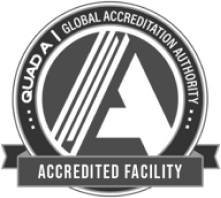
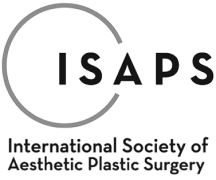
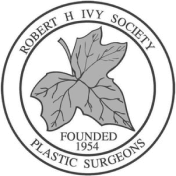
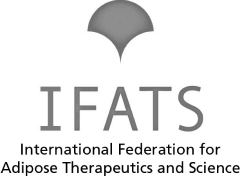
Is the procedure specifically for lower face, jawline and neck revitalization or is it considered a facelift?
This treatment is not a facelift or a neck lift. It does not require incisions or removal of skin, can be performed under local anesthesia in about one hour in the office, and requires little anesthesia and almost zero downtime. This method supports the foundation of the neck that the skin lies upon to really sculpt and refine the neck.
How long does it take to perform and what is the downtime?
This is an in-office procedure that only takes about one hour to perform. The patients go home wearing a chin strap and when they return the next day for their post-operative check-up they are just amazed to see their results. Most of them have very little bruising or swelling and could actually go to work the next day with minimal signs of a procedure. It is recommended, of course, no heavy lifting or heavy workouts at the gym, which is normal with most procedures. Also, there are no stitches or incisions so there is very little in the way of post-procedural care. Patients can shower the next day, although as mentioned previously, it is recommended not to work out at the gym for a couple of weeks because people who work out too soon will get more swelling.
“Everyone was professional and courteous. I was overwhelmed with the kindness and the way each person I met knew their job. The consultation flowed nicely from the care coordinator to the surgeon to the person who did the photography. The facility is stunning and I felt so confident and comfortable that I did not feel a second opinion was warranted.”
How is this technique different from a thread lift procedure?
This treatment is different to a thread lift for several reasons, the most important one being its longevity. The suture material used to create the support sling underneath the jawline is a permanent braided polyester suture, and where it is placed also differs from the thread lift (PDO threads or absorbable threads) in that they are placed a little bit deeper, right over the muscle and beneath the skin using the lighted suture rod. This is what allows plastic surgeons to travel in the exact location, not too close to the surface or too deep, to actually permanently support the glands and muscles of the neck. The light guidance makes the procedure much more accurate and with the permanent suture material, it is also much more long-lasting. The structure of the suture is different to PDO threads or absorbable threads, which are single strands sutures that are placed to sort of elevate skin. This suture is actually a continuous loop that goes underneath the entire area of the jawline and supports it over the long term. It is also non-absorbable, thereby making it more permanent.
How long do the results of the procedure last?
This treatment began in 2011 and patients are seven-plus years out with strong results.
Does this require general anesthesia?
No. This procedure is done under local anesthesia. When Dr. Claytor meets with his patients he always assesses and asks them would they be more comfortable with local anesthesia and there are few who say, “I’d rather be asleep.” 80 to 90% of patients prefer and are comfortable with local anesthesia available at Claytor Noone Plastic Surgery in Bryn Mawr.
- Key Benefits
- Glossary
- Offers a minimally invasive approach to tighten and contour the neck, reducing sagging skin and restoring a youthful appearance without the need for extensive surgery or scarring.
- Utilizes a specially designed suture system to provide long-lasting support to the neck tissues, promoting collagen production and improving skin elasticity for natural-looking results.
- Involves shorter recovery times compared to traditional neck lift surgery, allowing patients to return to their daily activities more quickly.
MyEllevate Neck Lift: A minimally invasive procedure designed to lift and tighten the skin around the neck without extensive surgery, focusing on providing a more youthful appearance with minimal downtime.
Minimally Invasive: Refers to procedures that are performed through tiny incisions instead of one large opening, resulting in less pain, a shorter recovery period, and reduced risk of infection.
Submental Area: The area beneath the chin and jaw, often targeted in cosmetic procedures to reduce sagging or fullness.
Suture: A stitch or a series of stitches used to close a wound or surgical incision.
Local Anesthesia: A type of anesthesia that blocks sensation in a specific area of the body, allowing patients to remain awake and comfortable during procedures.
Recovery Time: The period it takes for a patient to heal and resume normal activities following a medical procedure or surgery.
Jowls: A sagging, fleshy area around the jawline or chin, often addressed in cosmetic procedures to provide a tighter, more youthful appearance.
Platysmaplasty: Surgery that tightens and repairs the platysma muscle in the neck, often performed to alleviate sagging or banding in the neck area.
Non-Surgical Alternatives: Procedures that enhance physical appearance without surgery, often involving injectables, laser treatments, or other minimally invasive techniques.
Downtime: The necessary recovery period following a procedure during which the patient might need to rest, avoid certain activities, or take special precautions.
Incision: A cut or opening made by a surgical instrument during a procedure, allowing the surgeon access to the surgical site.
Skin Elasticity: The ability of the skin to return to its original shape and firmness after being stretched or compressed.
Collagen: A structural protein found in the skin and connective tissues, vital for maintaining skin elasticity and firmness. Collagen production diminishes with age, often leading to wrinkles and sagging skin.
Contraindications: Specific conditions or factors that increase the risks associated with a medical procedure, often indicating that a procedure should not be performed.
Why choose Dr. Claytor for your plastic surgeon?
Double Board-Certified for a high level of safety and precision
Chief of Plastic Surgery at Main Line Health, a top health system
Board Member of The Aesthetic Society, shaping the future of aesthetics
8x Philadelphia Magazine Top Doctor for exceptional patient care
Recognized as one of America’s Best Plastic Surgeons by Newsweek
Drain-free recovery expert for faster, more comfortable healing
Deep plane facelift innovator and global educator
Active researcher in surgical and non-surgical aesthetic advancements
Highly regarded for his surgical expertise and outcomes, as well as his dedicated follow-up care

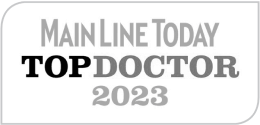

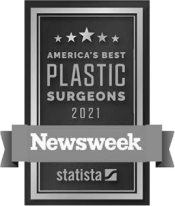

If you are interested in a neck lift, and would like to see if you are a good candidate, contact our Bryn Mawr office at (610) 527-4833 to schedule a consultation.
References »
Gomez DA, James IB, Turer DM, Trovato MJ, Pozner JN, Cook J, DiBernardo BE, Mueller GP. Light-Guided Percutaneous Neck Rejuvenation With Division of Platysma Bands and Suture Suspension: A Multicenter Retrospective Study. Aesthetic Surgery Journal. 2023 Mar 15;43(4):393-404. doi: 10.1093/asj/sjac287.
Giampapa VC, Mesa JM. Neck rejuvenation with suture suspension platysmaplasty technique: a minimally invasive neck lift technique that addresses all patients’ anatomic needs. Clinics in Plastic Surgery. 2014 Jan;41(1):109-24. doi: 10.1016/j.cps.2013.09.005.
Mueller GP, Leaf N, Aston SJ, Stone CW. The percutaneous trampoline platysmaplasty: technique and experience with 105 consecutive patients. Aesthetic Surgery Journal. 2012 Jan;32(1):11-24. doi: 10.1177/1090820X11429939.
Giampapa V, Bitzos I, Ramirez O, Granick M. Long-term results of suture suspension platysmaplasty for neck rejuvenation: a 13-year follow-up evaluation. Aesthetic Plastic Surgery. 2005 Sep-Oct;29(5):332-40. doi: 10.1007/s00266-005-0028-x.
Areas Served:

Medically reviewed by Dr. R. Brannon Claytor — Updated on Mar 26, 2025

